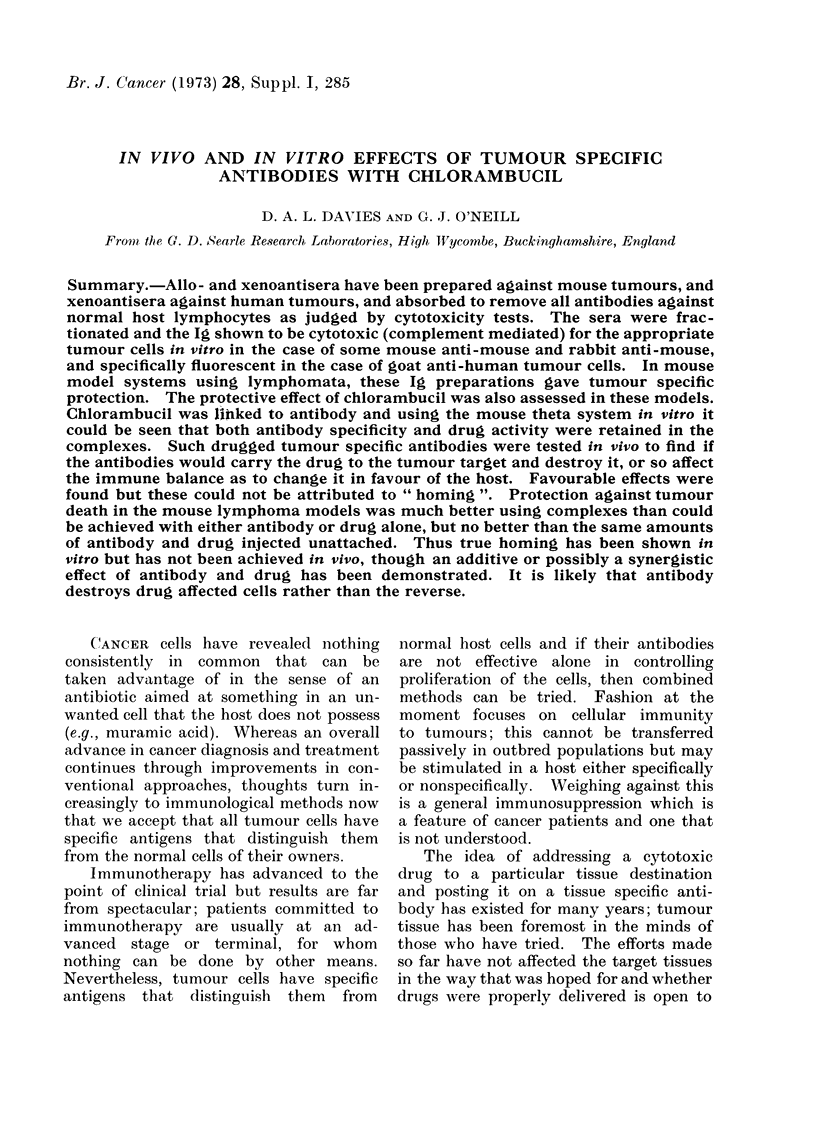Abstract
Allo- and xenoantisera have been prepared against mouse tumours, and xenoantisera against human tumours, and absorbed to remove all antibodies against normal host lymphocytes as judged by cytotoxicity tests. The sera were fractionated and the Ig shown to be cytotoxic (complement mediated) for the appropriate tumour cells in vitro in the case of some mouse anti-mouse and rabbit anti-mouse, and specifically fluorescent in the case of goat anti-human tumour cells. In mouse model systems using lymphomata, these Ig preparations gave tumour specific protection. The protective effect of chlorambucil was also assessed in these models. Chlorambucil was linked to antibody and using the mouse theta system in vitro it could be seen that both antibody specificity and drug activity were retained in the complexes. Such drugged tumour specific antibodies were tested in vivo to find if the antibodies would carry the drug to the tumour target and destroy it, or so affect the immune balance as to change it in favour of the host. Favourable effects were found but these could not be attributed to “homing”. Protection against tumour death in the mouse lymphoma models was much better using complexes than could be achieved with either antibody or drug alone, but no better than the same amounts of antibody and drug injected unattached. Thus true homing has been shown in vitro but has not been achieved in vivo, though an additive or possibly a synergistic effect of antibody and drug has been demonstrated. It is likely that antibody destroys drug affected cells rather than the reverse.
Full text
PDF













Selected References
These references are in PubMed. This may not be the complete list of references from this article.
- GORER P. A., AMOS D. B. Passive immunity in mice against C57BL leukosis E.L. 4 by means of iso-immune serum. Cancer Res. 1956 May;16(4):338–343. [PubMed] [Google Scholar]
- Ghose T., Nigam S. P. Antibody as carrier of chlorambucil. Cancer. 1972 May;29(5):1398–1400. doi: 10.1002/1097-0142(197205)29:5<1398::aid-cncr2820290542>3.0.co;2-d. [DOI] [PubMed] [Google Scholar]
- Ghose T., Norvell S. T., Guclu A., Cameron D., Bodurtha A., MacDonald A. S. Immunochemotherapy of cancer with chlorambucil-carrying antibody. Br Med J. 1972 Aug 26;3(5825):495–499. doi: 10.1136/bmj.3.5825.495. [DOI] [PMC free article] [PubMed] [Google Scholar]
- Leclerc J. C., Levy J. P., Varet B., Oppenheim S., Senik A. Antigenic analysis of L strain cells: a new murine leukemia-associated antigen, "L". Cancer Res. 1970 Jul;30(7):2073–2079. [PubMed] [Google Scholar]
- MATHE G., TRAN BA L. O. C., BERNARD J. Effet sur la leucémie 1210 de la souris d'un combinaison par diazotation d'A-méthoptèrine et de gamma-globulines de hamsters porteurs de cette leucèmie par hétérogreffe. C R Hebd Seances Acad Sci. 1958 Mar 10;246(10):1626–1628. [PubMed] [Google Scholar]
- Moolten F. L., Capparell N. J., Cooperband S. R. Antitumor effects of antibody-diphtheria toxin conjugates: use of hapten-coated tumor cells as an antigenic target. J Natl Cancer Inst. 1972 Oct;49(4):1057–1062. [PubMed] [Google Scholar]
- Moolten F. L., Cooperband S. R. Selective destruction of target cells by diphtheria toxin conjugated to antibody directed against antigens on the cells. Science. 1970 Jul 3;169(3940):68–70. doi: 10.1126/science.169.3940.68. [DOI] [PubMed] [Google Scholar]
- Schlesinger M., Cohen A., Hurvitz D. Inhibition by carbohydrates of the cytotoxicity of heterologous sera for mouse thymus cells. Isr J Med Sci. 1966 Sep-Oct;2(5):616–619. [PubMed] [Google Scholar]
- Staines N. A., O'Neill G. J., Guy K., Davies D. A. Xenoantisera against lymphoid cells: specificity and use in monitoring purification of mouse and human histocompatibility antigens. Tissue Antigens. 1973;3(1):1–21. doi: 10.1111/j.1399-0039.1973.tb00973.x. [DOI] [PubMed] [Google Scholar]


